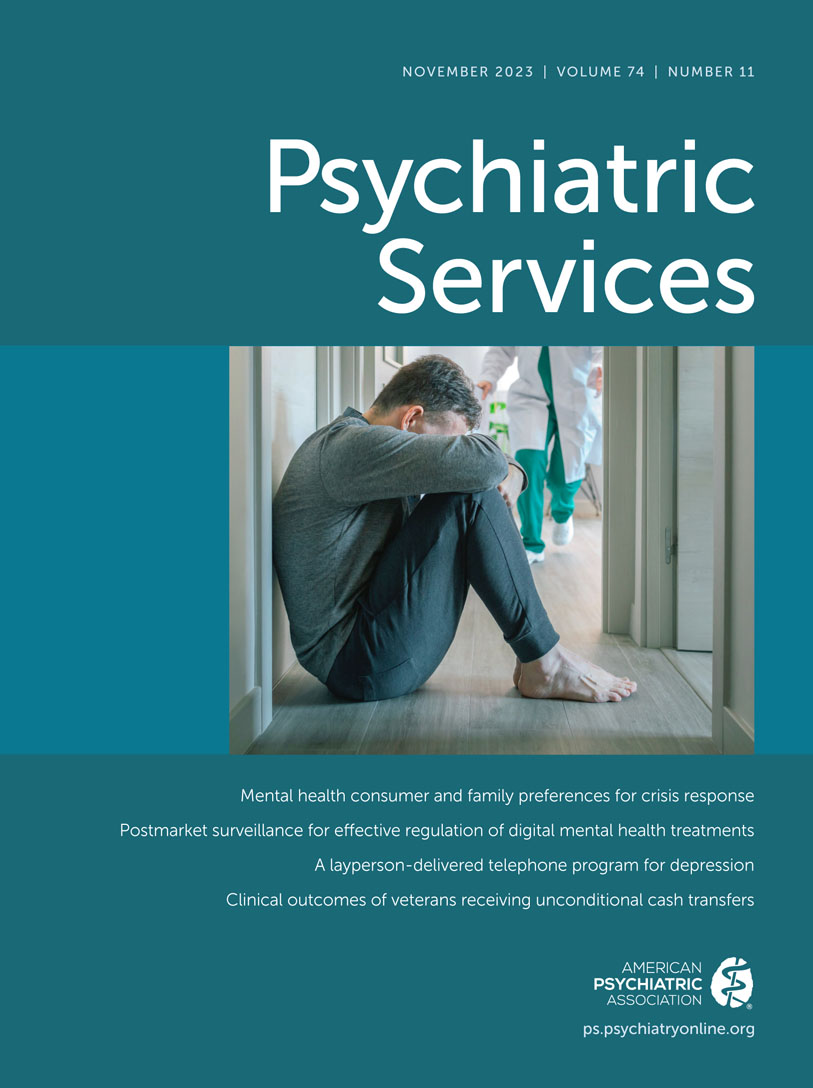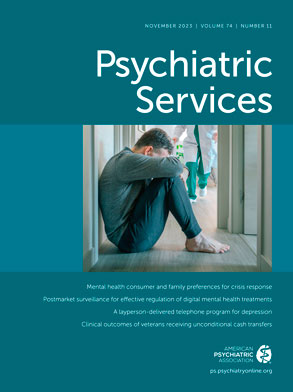From postemancipation sharecropping to modern banking discrimination, the production of debt has maintained racial and class oppression in the United States for centuries. The neoliberal explanation for debt and poverty is poor individual choice. In reality, discriminatory banking policies and predatory lending practices trap individuals with serious mental illness inside a cycle of debt and poverty.
In the 1980s, national banking conglomerates began to replace local lending institutions. As mainstream banks fled from poor, predominantly Black neighborhoods, fringe lenders such as pawnshops, rent-to-own stores, check cashers, and payday lenders moved in. Increasingly, low-income Americans whose credit needs had been met by community banks and credit unions turned to fringe lenders to cover basic expenses such as bills and rent (
1). Fringe loans can carry average annual interest rates between 400% and 600%, but they are often the only loans available to low-income individuals without good credit (
1). Generations of impoverished individuals, particularly people of color, have been denied affordable opportunities to build credit. As recently as 2015, Wells Fargo was sued for being twice as likely to provide Black consumers with high-cost loans, compared with White consumers with similar credit (
2). Moreover, people of color with low income are more likely to be subjected to overdraft fees, which generated $15 billion for banks in 2016 (
3).
Some types of debt, such as mortgages and business and car loans, can promote healthy cash flow and building of wealth. However, people with low income and serious mental illness are more likely to have the types of debt that negatively affect mental health—such as debt from fringe lenders (
4). Individuals with serious mental illness are more likely to rely on disability income, accrue more medical debt, and be subjected to more fees for unpaid bills. They are more at risk for legal involvement, where fees are charged at multiple levels of arrest and sentencing. Few constructs are as insidious and pervasive as debt, which can lead to garnished wages, trigger reincarceration, and jeopardize credit building, housing, employment, driver’s licenses, public benefits, and general medical and mental health (
5). To our knowledge, no quantitative analysis has focused on the breadth of debt experiences for individuals with serious mental illness and low incomes. This study expands the understanding of how clients at community mental health centers (CMHCs) are affected by debt. We aimed to highlight the role of financial justice in mental health recovery and equity.
Participants, Setting, and Procedures
Seventy-six clients of a CMHC in New Haven participated in this study. All participants were ages >18 years and diagnosed as having a serious mental illness. Participants learned about the survey through researchers at the center, flyers, and word of mouth. All participants provided verbal informed consent and were reimbursed with $10 in cash. The study was approved by the human subjects committee of Yale University.
Participants completed an anonymous survey on an encrypted, university-managed mobile device. The 63-item mobile survey was available in English and Spanish. Spanish- or English-speaking researchers were available to assist participants in reading the survey. A printed version of the survey was also offered; no participants chose this option. Participants responded to demographic questions on age, race-ethnicity, level of education, relationship status, children or dependents, housing status, and history of incarceration. On average, participants completed the survey in 15–30 minutes.
Health and Financial Health and Debt Assessments
Depression symptoms were assessed by using the Center for Epidemiologic Studies Depression Scale (CES-D) (
6), which was chosen consistent with previous studies on debt and mental health (
1). The CES-D is a 20-item assessment of depression symptoms over the past week. Total scores range from 0 to 60, and scores ≥15 are associated with clinical depression. In addition, participants reported the degree to which problems with mental or general medical health ever interfered with their functioning at work, home, or school. Participants also reported whether they had ever delayed mental health or general medical health care because of financial difficulties.
Participants reported income and current debts to the best of their knowledge. This survey assessed secured debts backed by collateral (mortgage or pawnshop or rent-to-own shop loans), unsecured debts (credit card debt, bank account overdraft, store credit or charge card, student loan, personal loan, online loan, or refund anticipation loan), and unsecured nonloan debts (arrears from rent, utilities, telephone bills, Internet bills, medical bills, child support, library fines, or traffic violations or costs related to incarceration or arrest). The categories of debt included in the survey were chosen on the basis of a series of focus groups held with low-income New Haven residents (
7). Degree of debt burden was assessed by number of debt types and how likely participants believed their debts would be resolved (e.g., “I will never be out of debt” or “I will be out of debt soon”). Last, participants identified primary reasons for financial difficulties in an open-ended section.
Statistical analyses were performed with SAS, version 9.4M6. Prevalence rates were calculated for individuals who met the cutoff for depression according to CES-D scores. Univariate analysis was performed with Fisher’s exact test to compare depressed and nondepressed groups. A p value of 0.05 was considered statistically significant.
Participant Demographic and Finance Characteristics
Most of the participants (39 of 74, 53%) were between 45 and 65 years old (mean=47.6±13.4 years, range 24 to 77), 50 of 76 (66%) were men, 58 (76%) were single, 30 (40%) self-identified as Black, and 30 (40%) self-identified as White. In total, 67 (88%) participants were housed, and 62 (82%) had some high school or college education; 34 (45%) had a history of incarceration. Of note, 59 (79%) of 75 of the participants had CES-D scores consistent with increased risk for clinical depression (
Table 1). Depression was significantly associated with three or more debt types, perceived high debt burden, perceived debt persistence, and inability to pay $400 in an emergency.
Among the participants, 58 (76%) earned ≤$1,000 per month, 32 (42%) received Social Security Disability Insurance (SSDI), and 30 (40%) received Supplemental Security Income (SSI); 53 (70%) received either SSDI or SSI, and nine (12%) received both. Overall, 43 (57%) received Supplemental Nutrition Assistance Program, and 58 (76%) managed their own money without representative payees, conservators, or money management. Thirty-five individuals (46%) reported having no current savings, and 38 (50%) did not currently have a bank account (
Table 1).
Of the study participants, 47 (62%) reported current debt, and 61 (80%) reported debt in the past 5 years (
Table 1). Individuals with debt were more likely to identify as Black, Indigenous, Asian, multiracial, or other race (N=30, 64%) than as White (
Table 2). Individuals with debt were also more likely to delay or skip mental health or general medical health care. History of incarceration was significantly correlated with past debt (p<0.05) but not current debt. Of note, 17 (36%) individuals with current debt had overdraft fees, the most common source of debt. Expenses for basic needs and bills were among the most common sources of debts, including rent, phone, electricity, and medical bills.
Perceptions of Financial Difficulties
Participants identified a range of primary reasons for financial difficulties. Several participants allocated income to necessities such as rent (“I gotta pay rent first, and after that, other things fall in place”), food, and medical care (“I don’t have health insurance, so I have to pay for all my medications”) before addressing debt. Other participants identified low income, unemployment, immigration status (“I would like to work, but I am not a citizen”), discrimination (“Racism. . . . I’d have better opportunities if I were White”), previous incarceration (“My criminal record. . . . I’ve learned from my mistakes. But [I have] a hard time trying to communicate this to employers”), and educational barriers (“If I had a degree, I would be more employable”) as factors for financial difficulties. Several individuals described the impact of borrowing and lending (“It’s hard to accept money from other people. I feel guilty.” and “It’s very hard to say no. My daughter owes me $900. Do you think I’m ever going to see it?”). Some experienced financial exploitation (“I have to spend my money. Otherwise, other people will take it from me”). Participants shared experiences with financial planning (“I’m able to balance my budget. I always call my bank to see I have enough in the bank”). One individual described mistrust of money management services (“I’m worried that my rep payee is pocketing some of the money. She is only giving me $75 when she could give me more”). Last, individuals identified health barriers to managing finances and debt (“[My] depression gets intense, and I can’t deal with anything”).
Discussion
The findings of this study indicate that individuals with serious mental illness, particularly people of color with low income, are poorly served by the financial services industry. They often lack access to basic banking services and are targeted for exploitative lending practices, resulting in damaging debt. The high prevalence of debt among participants was similar to that reported in previous studies of individuals with serious mental illness (
8). The prevalence of fringe borrowing (e.g., pawnshops) and nonloan debt, with their independent risk for increased debt, stress, and depression, was also comparably high (
4). This study is one of the first to focus on debt types that disproportionately affect impoverished people and people of color because of structural discrimination.
This study had several limitations. First, as a cross-sectional descriptive analysis with a small sample size, this study was not powered enough to adjust for confounding factors or to reveal causal associations between debt and depression or stress. Second, client responses were not validated with independent sources. Recall bias could have affected income reporting. Participants may also have been reluctant to divulge income from stigmatized sources such as under-the-table employment or criminalized activities. Last, we did not attempt to recruit a representative sample of CMHC clients, limiting the generalizability of our results. Our method of recruitment favored the inclusion of participants already engaged in mental health treatment at the CMHC where this survey took place. Other individuals experiencing distress or discomfort with the CMHC setting may have been excluded by study design and implementation.
Conclusions
Recognizing debt as a social determinant of health suggests a societal responsibility to intervene in the financial exploitation of individuals with serious mental illness and low income. As of 2020, nearly all U.S. states now place limits on annual interest rates of loans from fringe banks (
9). Moreover, several banks have joined the Bank On movement, a national initiative encouraging banks to offer certified accounts with no overdraft fees at low or no monthly cost (
10). Even though limiting fringe borrowing is a worthwhile goal, this type of borrowing is still a resource used by many to pay essential bills. As a result, the need to support public programs and mitigate structural factors of poverty remains. Efforts by clinicians, patient advocates, individuals with lived experience of debt and serious mental illness, and policy makers are needed to promote justice in financial and mental health.

